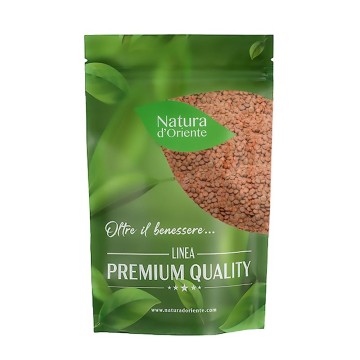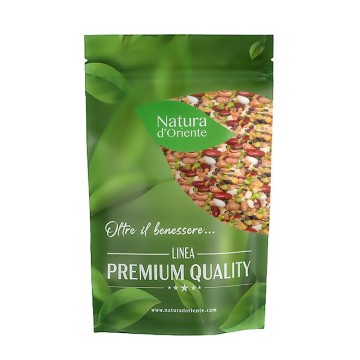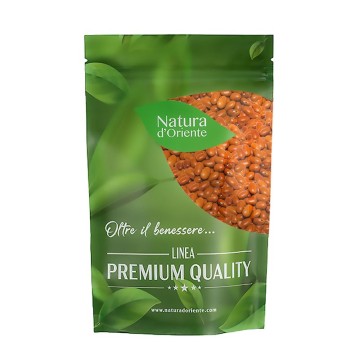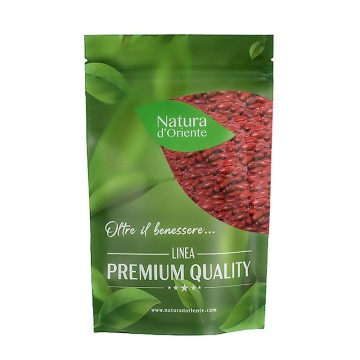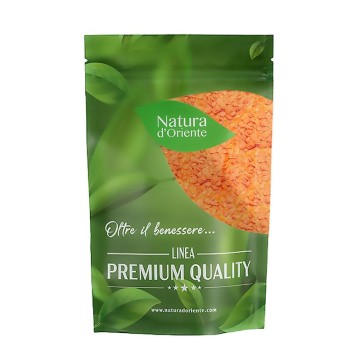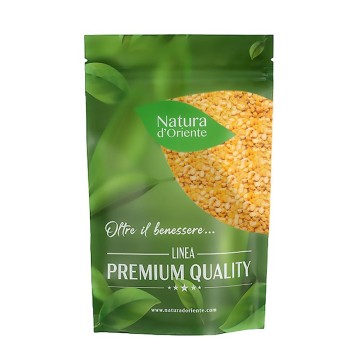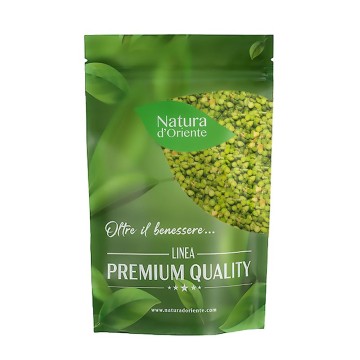The Borlotto bean is a variety grown to have beans with thicker skin . These beans resemble the pinto variety but have a creamier texture, and a chestnut-like flavor . Historically, they are also known for the benefits they bring to our health.
Borlotti beans: properties and benefits
Bean is a protein-dense food , an essential nutrient that supports structure formation in the body's tissues, and plays a role in muscle building and well-being. It is classified as a high-quality protein because pinto beans contain all 9 essential amino acids, which can only be obtained through food.
Excellent for a vegetarian or vegan diet, in combination with cereals, Borlotti beans provide all the proteins necessary for a healthy and complete nutrition.
Another valuable element is that pinto beans have a low glycemic index. The glycemic index defines foods based on their potential to increase blood sugar - and therefore risk for those who suffer from diabetes or want to avoid insulin resistance phenomena. Borlotti beans avoid the "glycemic spike", are slowly absorbed into the bloodstream, which also gives satiety and prevents increased hunger.
Borlotti beans help improve digestion, like many legumes, as they are rich in dietary fiber. Fiber helps prevent constipation by making intestinal transit more regular. Furthermore, soluble fiber can help reduce appetite, and dietary fiber is suitable for balancing the level of LDL or bad cholesterol.
Borlotti beans can help in a diet that is beneficial to the cardiovascular system, since the potassium contained maintains a correct blood pressure.
In addition to this, a vitamin found in beans such as folate also contributes to the reduction of hypertension and relaxes blood vessels, maintaining proper blood flow.
Folate and vitamin B1 also play a useful role in regulating specific amino acids that the nervous system requires.
Thanks to the presence of copper and iron in Borlotti beans, these foods can help stimulate the formation of blood cells. Copper and iron are essential for the formation of hemoglobin, and consequently for the correct transport of oxygen in the body.
An iron deficiency, plus, we know it can lead to fatigue and lack of energy. For this reason, adding beans to the diet prevents these symptoms and energizes our body. Vitamins B6 and B12 from beans are also useful during the red blood cell production process.
The vitamins and minerals of the Borlotti beans are able to give benefits to maintain a good metabolism. For example, vitamins B1, B2 and B6 are excellent for a correct metabolism of carbohydrates, proteins and fats into energy.
In addition, beans also have a high level of calcium, which is useful for the well-being of our bones and teeth.
Origins and History of cultivation
The common bean we know, Phaseolus vulgaris, is a legume native to Mexico and Central America. Although beans were widespread throughout the Mediterranean, with the African species Vigna unguiculata (cowpea), these American varieties soon took their place for greater yield and ease of cultivation.
It was imported to Europe by the Spaniards, and it easily adapted to our land in the sixteenth century.
The consumption of beans, however, was already widespread in Greek and Roman times, and continued throughout the Middle Ages with the so-called black-eyed beans (light but with a dark dot corresponding to the insertion of the pod). Historically, the combination of beans and cereals, with pasta in Italy, represented a protein substitute for meat.
After the spread of the American bean, numerous varieties were produced (over 14,000), including the Borlotti beans.
These beans are always of American origin, and have their typical cream color mottled with dark red. The name borlotto presumably derives from the northern verb borlare, which means to roll or fall; its root (bor) indicates "round body", and the adjective borlotto became a way to highlight the round shape of these legumes.
They are among the most popular, and were among the first to replace European bean species. They were simpler to grow, more productive per plant, and very tasty. We know that they were also used in crop rotation, to enrich the soil with nitrogen: legumes, in fact, live in symbiosis with the bacteria that fix nitrogen from the atmosphere to the soil.
Other varThe most common are the Lamon beans, a variant of the Borlotti, grown in the territory of Belluno), the white cannellini beans, the white beans of Spain, and the black beans, known in Mexican cuisine. Another variety is that of red beans, which have a floury pulp.
Today there are many producers in the world, and there are dried, fresh, frozen and canned beans on the market.
Plant and Fruit
The bean plant is Phaseolus vulgaris L. which is part of the Fabaceae family. It is an annual, hardy, easy to grow plant. It is widely cultivated around the world for its delicious seeds, which grow in pods.
This ancient crop, like many other legumes, has the ability to fix nitrogen from the air to the soil, through a symbiotic relationship with the bacteria housed in the roots. Consequently, the bean is rich in protein.
The impressive diversity of colors, textures and flavors of the common bean varieties makes it very popular.
The varieties with a longer vegetative cycle are sown in spring, those with a shorter cycle in summer and harvested in autumn. In particular, the small pinto bean plant makes the seeds ready to harvest in the fall, 80 to 120 days after sowing.
Autumn harvests tend to be better, as the pod has undergone temperature changes becoming more tender and flavorful.
The mountain borlotto bean is in fact very delicious, and these plants are less prone to parasitic attacks.
Nutritional values of Borlotti beans
These legumes are known for their beneficial food values. By examining at a nutritional level 100 grams of Borlotti Beans, we know that they provide 286 kcal , less than other legumes; they also contain not excessive fats (2.1%), proteins (20.4%), not excessive carbohydrates and fibers (about 18%).
Among the mineral salts are present in Borlotti beans, moderate levels of calcium, iron (about 5 mg), potassium (about 1300 mg), magnesium (about 150 mg), copper (about 0.80 mg). < / p>
By consuming Borlotti beans, one assimilates mainly B vitamins, such as thiamin (about 0.7 mg), niacin, good doses of folate - vitamin B9 (about 600 µg).
Beans also contain zinc, phytosterols, isoflavones and saponins which are useful for our health.
How to consume Borlotti beans in the kitchen
They have a sweet taste, a creamy and soft texture - some say "meaty" texture. Borlotti beans tend to keep their smooth texture at room temperature, so they can be added to hot and cold recipes without worry.
This is why Borlotti beans work well in salads, and lend themselves to infinite variations of recipes, in particular soups, soups, with rice or pasta. Pasta and beans are famous - for centuries the alternative nourishment to meat, at the protein level.
There are many recipes we can create with these beans, which can be combined in kitchens all over the world also with polenta, potatoes, sausages ... the stew , or as protein side dishes.
The dried variety should be soaked in cold water before cooking. You need to soak about 6 hours before cooking, which will be 1 hour - it will make these beans soft but still full-bodied.
Recipe with Borlotti beans: Chicken with beans and black cabbage
Ingredients: 200 g of pinto beans, drained and rinsed - 2 tablespoons of olive oil - 4 chicken legs - 100 g of Black Cabbage - 1 onion cut into slices - 1 clove of minced garlic - 1 sprig of rosemary - 50 ml of dry white wine - 125 ml of chicken broth - Parmigiano Reggiano crust.
Preparation: Preheat the oven to 180 ° C. Heat the oil in a saucepan over medium-high heat. Season the chicken thighs and brown them skin-down in the oil for 5 minutes, brown them, then flip and fry them for another 2 minutes. Remove them from the saucepan and set aside.
In the meantime, remove the kale leaves from the stems, chop the stems finely and cut the leaves into wide strips.
Add the onion and black cabbage stalks to the casserole, and season with salt to taste. Fry for 5 minutes, until the ingredients soften and turn golden. Then add the garlic and rosemary, and sauté for another 2 minutes.
Stir in the wine and boil everything for the reduction (until reduced by half). Then add the broth and borlotti beans, and a small parmesan crust.
Return the chicken to the saucepan, then transfer to the oven and cook for 25 minutes.
Lift the chicken and insert the kale leaves. Re
![]()





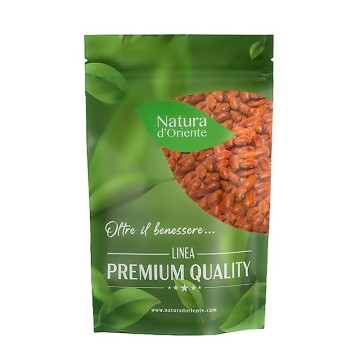



 No reward points for this product.
No reward points for this product.



